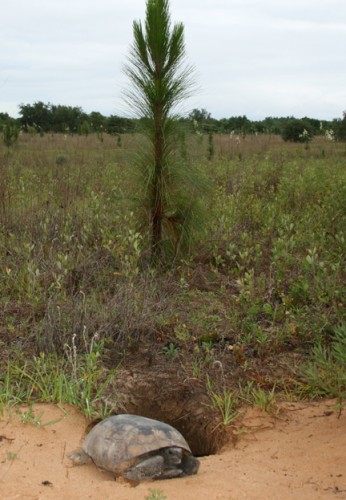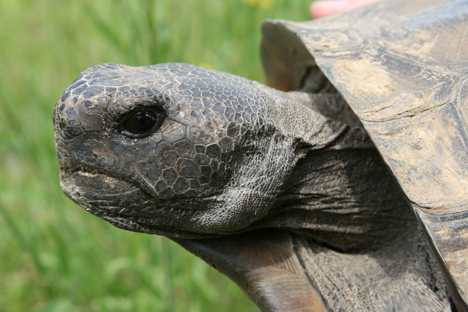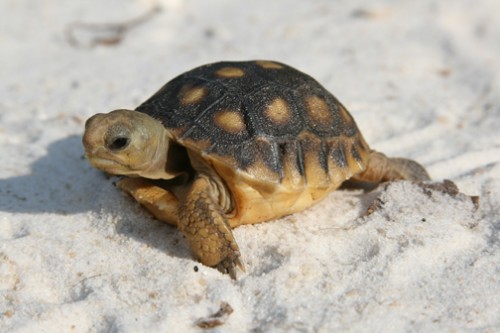
More than 3,400 tortoises thrive at preserve in Walton County
In its natural habitat many years ago, the gopher tortoise was a thriving species in Northwest Florida. This medium-sized tortoise with a gray or amber to dark brown shell is as old as the sandhills it loves. It is one of the oldest species on Earth, dating back to the Pleistocene Epoch – the Ice Age. Gopher tortoises are long-lived reptiles that occupy upland habitat throughout Florida including forests, pastures, and yards. They dig deep burrows for shelter and forage on low-growing plants. Gopher tortoises share these burrows with more than 350 other species, and are therefore referred to as a keystone species.
Despite surviving the perils of geological time, during just the past three decades, the rate of decline for the species exceeded 30 percent, prompting the Florida Fish and Wildlife Conservation Commission (FWC) to list the gopher tortoise as threatened, and taking regulatory action to help protect the species. To assist in protecting the species, FWC established a management plan for the tortoises, which includes relocation of the species from development areas.
The historic declines of the gopher tortoise throughout the southern portions of the State have been caused by land development. In the Florida Panhandle it was due to severe and unsustainable human harvest of tortoises for their meat.

Nokuse Plantation, a private preserve in Freeport is the perfect habitat for the gopher tortoise. Its well-drained sandy soils, open canopy, abundance of herbaceous groundcover forage available on 22,000 of the preserve’s 51,000 acres, has been the new home to many relocated tortoises from across the State of Florida; more than 3,400 since 2006.
This year, 348 have been relocated to the preserve. Nokuse is permitted by FWC to relocate gopher tortoises at a density of 3 tortoises per acre.
“We only had about 300-500 native gopher tortoises on our preserve prior to the start of the relocations” said Matt Aresco, director of Nokuse Plantation. “Historic (pre- European settlement) gopher tortoise density on Nokuse Plantation was probably more than 50,000 adults (2 per acre). Nokuse Plantation is actively restoring gopher tortoise sandhill habitat by removing plantations of off-site pines, conducting prescribed burns, restoring native groundcover plants, and replanting longleaf pine.”
It will take a several years for the population to increase on its own at Nokuse. Gopher tortoises have delayed sexual maturity (15-20 years), low rates of reproduction and recruitment, and are spatially isolated at low densities (reducing mating opportunities), the only way to restore depleted and extirpated populations is by translocation. Thus, translocation of gopher tortoises from development sites to reestablish or augment populations on public and private conservation land is a critical part of State and federal conservation plans for the species.

Most of the gopher tortoises that Nokuse relocates come from pre-2008 incidental take permits issued by the Florida Fish and Wildlife Conservation Commission from lands that are only now being developed (mostly in central Florida and northeast Florida). From 1991 to 2007, Florida issued incidental take permits to developers in exchange for habitat mitigation fees that were used to purchase gopher tortoise habitat elsewhere, but resulted in the loss of an estimated 103,000 tortoises and a net loss of gopher tortoise habitat. New FWC permitting requirements in July 2007 eliminated the incidental take permit policy and replaced it with a new permitting system designed to protect suitable, managed habitat and require translocation. However, the old incidental take permits issued prior to July 2007 have no expiration date and although many of these lands currently remain undeveloped, an estimated 22,000 gopher tortoises will be legally entombed in the future as these lands are developed. Due to the lull in the housing market and the resulting slowdown in development, thousands of these tortoises are still living on properties where developers hold a permit to bury them alive. The housing market is currently in recovery and development has started once again throughout many areas of Florida, placing these tortoises back in harm’s way. FWC allows a modification to the original incidental take permit to allow for off-site relocation. However, most developers will not pay any additional cost to relocate the tortoises as they already paid significant fees for the original incidental take permits.
The cost to relocate these tortoises includes backhoe excavation of burrows on the development sites, transport to Nokuse Plantation, and construction of temporary enclosures to ensure site fidelity of relocated tortoises. Nokuse Plantation and the Humane Society of the US have partnered to save these gopher tortoises since 2007. The Humane Society of the United States has received grant funding and donations over the last four years to cover the cost of these relocations.
Nokuse Plantation is a 51,000-acre private preserve that connects to Eglin AFB on the west and Chocatawhatchee WMA on the east. The purpose of Nokuse Plantation is to provide a wildlife preserve and habitat linkage area between existing State and Federal lands in an effort to support historic biodiversity. To learn more about Nokuse Plantation, go to: nokuse.org
Click here to learn more about gopher tortoises: gopherinfo
To learn more about gopher tortoise permitting, click here.
